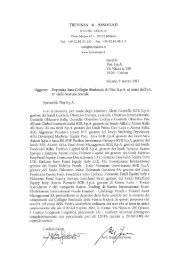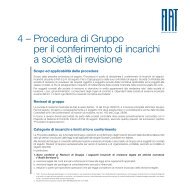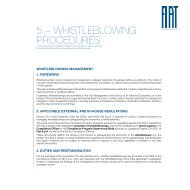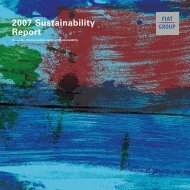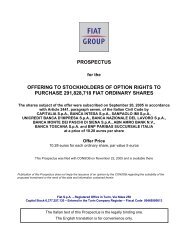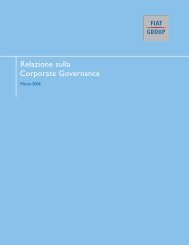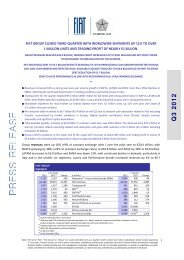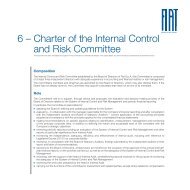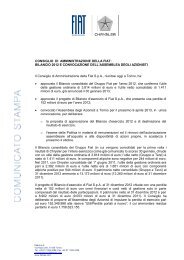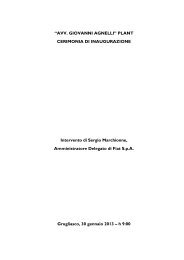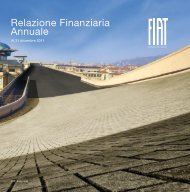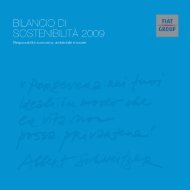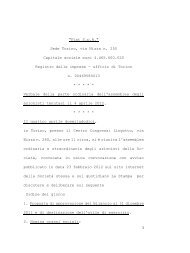2006 Annual Report - Fiat SpA
2006 Annual Report - Fiat SpA
2006 Annual Report - Fiat SpA
Create successful ePaper yourself
Turn your PDF publications into a flip-book with our unique Google optimized e-Paper software.
Sustainability <strong>Report</strong><br />
Economic, environmental<br />
and social responsibility<br />
Now in its third year, the Group’s Sustainability <strong>Report</strong> attests<br />
to the importance that <strong>Fiat</strong> assigns to full, open disclosure,<br />
not just of the information that demonstrates financial<br />
accountability, but in terms of social and environmental<br />
responsibility as well.<br />
The <strong>2006</strong> Sustainability <strong>Report</strong> is the result of the Group’s firm<br />
commitment to achieving the kind of reporting that best<br />
reflects its organisation and the needs of its stakeholders:<br />
a commitment that grows stronger with every passing year.<br />
Thus, the prize for the year’s best reporting initiative that FERPI,<br />
the Italian Public Relations Federation, conferred on the Group’s<br />
<strong>Annual</strong> <strong>Report</strong> in 2005 did more than reward the efforts of all the<br />
people at <strong>Fiat</strong> who share this commitment: it spurred them to do<br />
better, and demonstrate that the praise that was well-earned then<br />
is still richly deserved. This is one of the reasons that the <strong>2006</strong><br />
Sustainability <strong>Report</strong>, though continuing the work done in<br />
previous years, introduces several major changes. They are<br />
changes designed to meet several key needs: the need to<br />
increase inclusiveness by reaching out to all of the Company’s<br />
stakeholders and speaking a language they can all respond to;<br />
the need to let analysts and opinion leaders know how well the<br />
Company measures up in such important areas as corporate<br />
social responsibility and ethical finance; the need to follow<br />
Global <strong>Report</strong>ing Initiative guidelines even more closely.<br />
To enable stakeholders to gauge the Group’s contribution to<br />
sustainable growth, the <strong>Report</strong> illustrates the work done during<br />
the year from the standpoint of its economic, environmental<br />
and social impact. After presenting the <strong>2006</strong>’s<br />
accomplishments, the measures introduced to promote<br />
greater stakeholder engagement, and an overview of the<br />
Company’s organisation and corporate governance structure,<br />
the <strong>Report</strong> uses the three-dimensional Triple Bottom Line<br />
approach to measure its work against performance<br />
indicators that go beyond classic financial reporting criteria.<br />
As such, it is divided into three sections, where information<br />
is grouped according to the stakeholders concerned in order<br />
to ensure greater clarity.<br />
As the section on economic responsibility illustrates, <strong>Fiat</strong><br />
continued to focus on value creation and boosting the<br />
Group’s financial ratings and competitiveness, putting the<br />
customer square at the centre of its growth strategies and<br />
partnering with other major international groups.<br />
16 <strong>Report</strong> on Operations Sustainability <strong>Report</strong> – Economic, environmental and social responsibility<br />
In the section on environmental responsibility, the Group<br />
provides a comprehensive view of its attention to ensuring<br />
sustainable manufacturing practices at its production plants<br />
and to developing products with the lowest impact on<br />
the environment by reducing energy consumption, cutting<br />
emissions and increasing efficiency. In addition, the section<br />
illustrates research work carried out and its applications<br />
on environmentally-friendly mobility and traffic safety.<br />
The section on social responsibility scrutinises the Group’s<br />
relationship with its worldwide workforce and the public. This<br />
section provides details and statistics about employees and<br />
hiring policies, as well as discussing the initiatives promoted<br />
in favour of young people, health and safety, equal<br />
opportunities, education and training and employee benefits.<br />
The section concludes with a description of the Group’s<br />
community outreach efforts, including programs for helping<br />
people with physical disabilities retain their mobility.<br />
The <strong>Report</strong> is posted in the Sustainability section of the<br />
Group’s website at www.fiatgroup.com, where stakeholders<br />
are invited to provide their feedback regarding the Company’s<br />
corporate social responsibility by filling in the questionnaire<br />
or sending e-mails at csr@fiatgroup.com.<br />
Research and Innovation<br />
To promote sustainable mobility on multiple fronts, the <strong>Fiat</strong><br />
Group has organised its research and innovation work through<br />
two companies, the Centro Ricerche <strong>Fiat</strong> (<strong>Fiat</strong> Research Centre)<br />
and Elasis, whose strategies are coordinated by the Technical<br />
Committee of the Group Executive Council.<br />
In <strong>2006</strong>, the Group’s research and development expenses 1<br />
amounted to approximately 1.6 billion euros or around 3.2%<br />
of net industrial activities. Overall, R&D activities involve some<br />
13,200 people at 116 centres.<br />
Centro Ricerche <strong>Fiat</strong> (<strong>Fiat</strong> Research Centre)<br />
The Centro Ricerche <strong>Fiat</strong> provides the Group with effective,<br />
innovative solutions at competitive prices, ensuring smooth<br />
technology transfer by further increasing the professional<br />
qualification of personnel through training. This enables<br />
the Centre to play an active role in supporting technological<br />
growth for the <strong>Fiat</strong> Group, its partners and the communities<br />
where they work in such fields as motor vehicles and<br />
componentry, energy, safe and environmentally-friendly<br />
mobility, telematics, innovative materials and relevant<br />
technologies, mechatronics and optics.<br />
In particular, the Centre’s work in innovative powerplants,<br />
alternative propulsion systems and transmissions<br />
is conducted through Powertrain Research and Technology<br />
headed by <strong>Fiat</strong> Powertrain Technologies, the <strong>Fiat</strong> Group Sector<br />
set up in May 2005 which groups together all of the Group’s<br />
activities in this area.<br />
In addition to its headquarters in Orbassano on the outskirts<br />
of Turin, the Centro Ricerche <strong>Fiat</strong> has four branches in Bari,<br />
Catania, Trento and Foggia, as well as a controlling interest<br />
in the C.R.P. Plastics and Optics Research Centre in Udine,<br />
whose work focuses on advanced research in the field of optics<br />
and plastics for automotive lighting systems. With a staff<br />
of 870 employees, the Centro Ricerche <strong>Fiat</strong> made significant<br />
progress during the year, as witnessed by the 61 new patent<br />
applications it filed in <strong>2006</strong>, bringing the total number of<br />
patents held by the Centre to over 2,100. A further 900 patents<br />
are currently pending. In addition, the Centro Ricerche <strong>Fiat</strong><br />
was awarded 128 projects in the EU’s Sixth Framework<br />
Program, confirming its leadership in European research. The<br />
Centro Ricerche <strong>Fiat</strong> cooperates with over 150 universities<br />
and research centres, and more than 750 industrial partners<br />
around the world. This network further strengthens the<br />
(1) Includes capitalised research and development expenses and those charged directly against income for the year.<br />
Centre’s global innovation strategies, ensures that it can<br />
implement specific operations at the local level, and helps<br />
it create skills and monitor its competitiveness and growth.<br />
Further information is available on the Centre’s website at<br />
www.crf.it.<br />
The work of the Centro Ricerche <strong>Fiat</strong> focuses on several key<br />
areas of technology.<br />
Powertrain Research and Technology<br />
The major objective in this field is to develop and apply<br />
innovative technologies for improving powerplant performance,<br />
cutting engine and vehicle emissions, and boosting fuel<br />
economy. The Centro Ricerche <strong>Fiat</strong>’s most significant<br />
accomplishments for <strong>2006</strong> in this area are reviewed below:<br />
■ Multijet II. As part of <strong>Fiat</strong> Powertrain Technologies R&D<br />
efforts, predevelopment work on the new Multijet II diesel<br />
injection system was completed in <strong>2006</strong>. This system is able to<br />
manage the multiple injection process developed for the earlier<br />
Multijet without the latter’s limitations on the distance between<br />
successive injectors, thus bringing significant performance<br />
benefits. The high-pressure pump was also redesigned,<br />
reducing significantly costs.<br />
■ Two-cylinder spark ignition engine. Alongside Multiair<br />
electronic valve control technology, downsizing is another<br />
stepping stone in <strong>Fiat</strong> Powertrain Technologies’ strategic path<br />
towards achieving minimal CO 2 emissions. Thus, work is now<br />
concentrating on developing small supercharged engines that<br />
can replace naturally aspirated powerplants with larger<br />
displacements. In <strong>2006</strong>, the first version of a supercharged<br />
two-cylinder Multiair engine was developed, and prototypes<br />
were put through their paces in an array of bench and<br />
on-vehicle tests that assessed their potential in terms<br />
of performance, fuel economy and noise emissions.<br />
■ Panda Hydrogen. For all of the intense effort that has gone<br />
into development and testing, hydrogen powered vehicles<br />
plying our streets and highways are still a long way in the<br />
future. But with an eye to that future, the <strong>Fiat</strong> Group<br />
is concentrating on small, fuel cell city cars: the Seicento<br />
Elettra H2 Fuel Cell unveiled in 2001, the Seicento Hydrogen<br />
<strong>Report</strong> on Operations Research and Innovation 17



